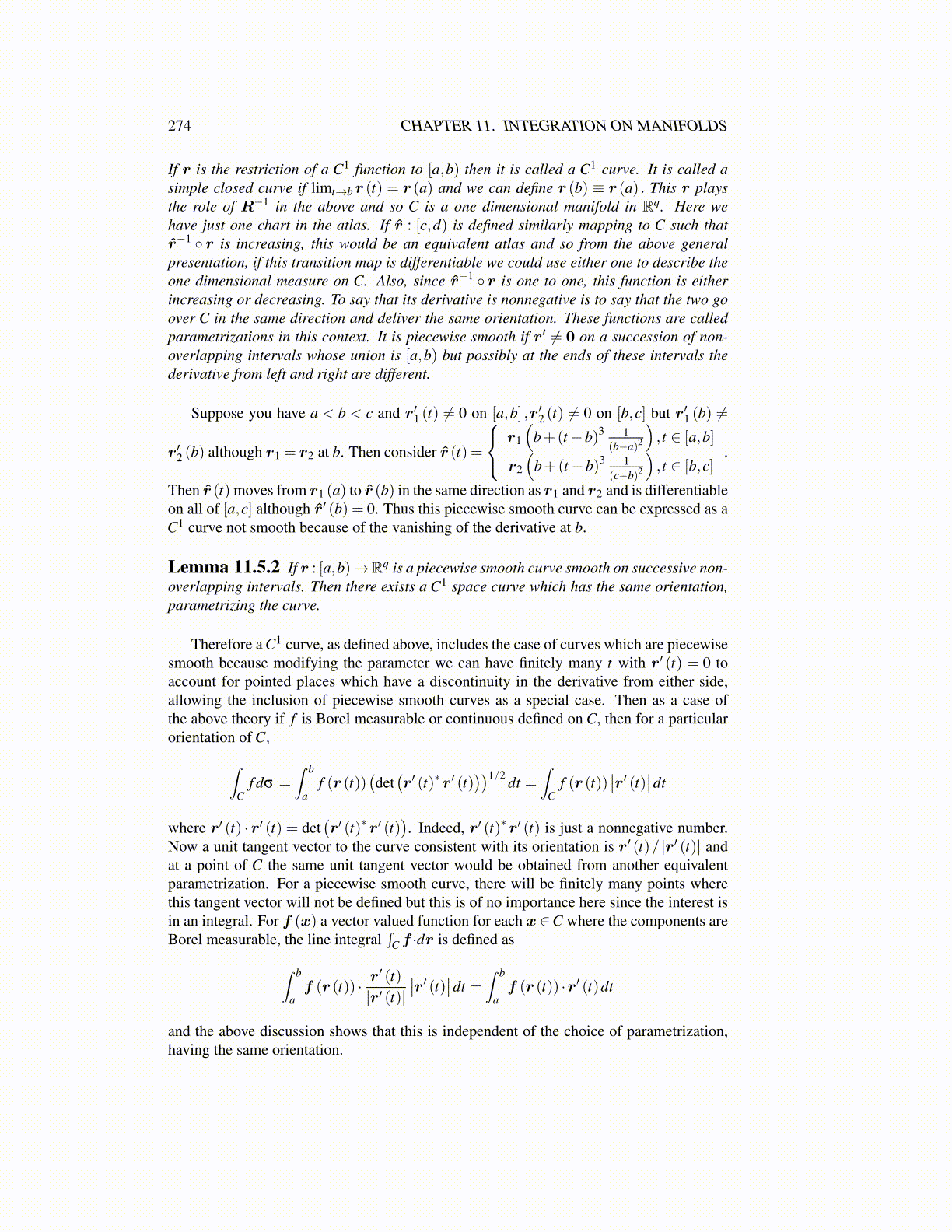
274 CHAPTER 11. INTEGRATION ON MANIFOLDS
If r is the restriction of a C1 function to [a,b) then it is called a C1 curve. It is called asimple closed curve if limt→b r (t) = r (a) and we can define r (b) ≡ r (a) . This r playsthe role of R−1 in the above and so C is a one dimensional manifold in Rq. Here wehave just one chart in the atlas. If r̂ : [c,d) is defined similarly mapping to C such thatr̂−1 ◦ r is increasing, this would be an equivalent atlas and so from the above generalpresentation, if this transition map is differentiable we could use either one to describe theone dimensional measure on C. Also, since r̂−1 ◦ r is one to one, this function is eitherincreasing or decreasing. To say that its derivative is nonnegative is to say that the two goover C in the same direction and deliver the same orientation. These functions are calledparametrizations in this context. It is piecewise smooth if r′ ̸= 0 on a succession of non-overlapping intervals whose union is [a,b) but possibly at the ends of these intervals thederivative from left and right are different.
Suppose you have a < b < c and r′1 (t) ̸= 0 on [a,b] ,r′2 (t) ̸= 0 on [b,c] but r′1 (b) ̸=
r′2 (b) although r1 = r2 at b. Then consider r̂ (t) =
r1
(b+(t−b)3 1
(b−a)2
), t ∈ [a,b]
r2
(b+(t−b)3 1
(c−b)2
), t ∈ [b,c]
.
Then r̂ (t) moves from r1 (a) to r̂ (b) in the same direction as r1 and r2 and is differentiableon all of [a,c] although r̂′ (b) = 0. Thus this piecewise smooth curve can be expressed as aC1 curve not smooth because of the vanishing of the derivative at b.
Lemma 11.5.2 If r : [a,b)→Rq is a piecewise smooth curve smooth on successive non-overlapping intervals. Then there exists a C1 space curve which has the same orientation,parametrizing the curve.
Therefore a C1 curve, as defined above, includes the case of curves which are piecewisesmooth because modifying the parameter we can have finitely many t with r′ (t) = 0 toaccount for pointed places which have a discontinuity in the derivative from either side,allowing the inclusion of piecewise smooth curves as a special case. Then as a case ofthe above theory if f is Borel measurable or continuous defined on C, then for a particularorientation of C,
∫C
f dσ =∫ b
af (r (t))
(det(r′ (t)∗ r′ (t)
))1/2 dt =∫
Cf (r (t))
∣∣r′ (t)∣∣dt
where r′ (t) ·r′ (t) = det(r′ (t)∗ r′ (t)
). Indeed, r′ (t)∗ r′ (t) is just a nonnegative number.
Now a unit tangent vector to the curve consistent with its orientation is r′ (t)/ |r′ (t)| andat a point of C the same unit tangent vector would be obtained from another equivalentparametrization. For a piecewise smooth curve, there will be finitely many points wherethis tangent vector will not be defined but this is of no importance here since the interest isin an integral. For f (x) a vector valued function for each x ∈C where the components areBorel measurable, the line integral
∫C f ·dr is defined as
∫ b
af (r (t)) · r
′ (t)|r′ (t)|
∣∣r′ (t)∣∣dt =∫ b
af (r (t)) ·r′ (t)dt
and the above discussion shows that this is independent of the choice of parametrization,having the same orientation.